Where the Germans are
In southern Minnesota, New Ulm hangs on to a colorful heritage.
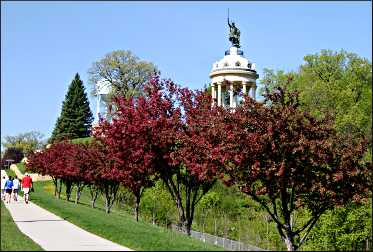
© Beth Gauper
There are few towns more conspicuously American than New Ulm, Minn.
Laid out by the town founders, its wide streets follow an orderly grid toward downtown, where cars park at an angle in front of boxy brick businesses and meat-and-potatoes cafes.
There are softball games and Friday-night fish fries and many friendly people. It's the epitome of small-town America-and yet this is a town famous for being German.
There are hints, for sure. On a lonely plaza downtown, the carillon bells of a concrete-and-brick Glockenspiel chime three times a day as animated figures revolve below, like a cuckoo clock.
Gift shops stock nutcrackers and wood pyramids, and there are gnomes in the window of the used-books store.
Atop a 70-foot columned dome, the Teutonic folk hero Hermann brandishes his sword over town.
But at first glance, New Ulm doesn't look or sound much like a German town, despite the oompah music the chamber of commerce pipes onto the street.
The qualities associated with Germans — thrift, practicality, industriousness — turned out to be such a happy match for small-town America that now it's hard to tell the difference.
Settled by Turners
Ironically, the first New Ulmers were not typical small-towners at all.
They were Turners, members of a society that promoted universal education, German culture and physical fitness through gymnastics. Many were socialists who had fled Germany after the nobility suppressed a wave of democratic revolts in 1848.
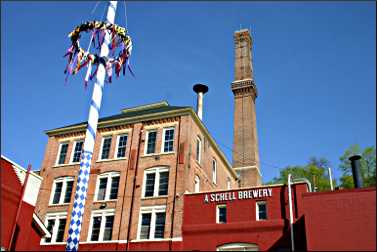
© Beth Gauper
From groups in Chicago and Cincinnati, they formed a land company that, in 1854, found and bought a site for a town in Minnesota, at the confluence of the Minnesota and Cottonwood rivers.
Calling themselves "free-thinkers," the Turners advocated the separation of church and state, women's rights and the abolition of slavery. They were largely agnostic, and they liked to get together and drink beer on Sundays.
This enraged such people as Harriet Bishop, a Baptist missionary better known as St. Paul's first schoolteacher.
"With no religious restraints, they became strong in wickedness (and) defiant of the restraints of the Gospel," she wrote.
New Ulm has changed over the years. Today, it's politically conservative and home of a college and high school operated by the Wisconsin Evangelical Lutheran Synod, which is so conservative it doesn't allow women to vote on church matters or take on any church roles that involve authority over men.
The people still like to drink beer, though. And New Ulm still is the most German city in Minnesota, with 66 percent of its residents claiming German ancestry in the 2000 census, as opposed to 38 percent of the state at large.
That's why I finally had to take my German-born husband there to see it. Since arriving here in 1997, he'd been noticing the highway billboards: "Discover Germany in Minnesota."
Let the good times roll
Luckily, I knew just where to take him. On previous trips, I'd hobnobbed with masked Narren at Fasching, the German equivalent of Mardi Gras.
I'd flapped my elbows to the "Little Chicken Dance" at a New Ulm festival. And I'd scoured the town's shops for blown-glass ornaments and Advent calendars at Christmas.
Our first stop was Schell Brewery, whose picturesque grounds are a kind of town square in New Ulm.
It always has been a neighborly place; when the Dakota Indians lay siege to the town in 1862, the 2-year-old brewery was left unharmed because its owners had shared food with them.
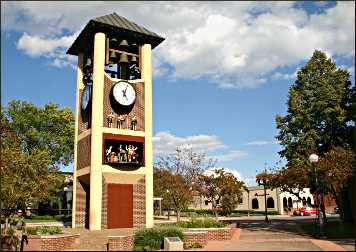
© Beth Gauper
August Schell was one of the original Turners and always allowed visitors to wander the wooded grounds around his 1885 brick home; current proprietor Ted Marti, his great-great-grandson, does the same.
As we drove through the neighborhoods toward the brewery, Torsten made his first observation about New Ulm.
"I hate to say it, but this looks very tidy," he said.
The town isn't German for nothing. The brewery still has the black pines that August's son, Otto, brought over from the family hamlet near the Black Forest.
As we walked down the paths and past a fanciful fountain designed by German-Bohemian artist Anton Gág, one of August Schell's proteges, we heard a sound not unlike a fingernail scraped down a blackboard.
It was coming from a peacock perched on a sawhorse. As soon as it saw us, it jumped onto the grass, shot out its cobalt feathers and began a slow pirouette, like a runway model.
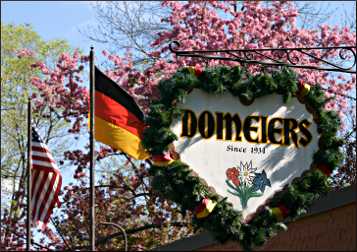
© Beth Gauper
We walked on the Museum of Brewing, which has a handsome Rathskeller and patio for visitors on the brewery tour.
In the gift shop, T-shirts displayed the Schell slogans: "Never Ask a Gnome to Hold Your Beer," "Never Trust a Brewery Under 140 Years Old" and "When You're Surrounded by 14,000 Thirsty Germans, You Better Make a Darn Good Beer!"
Goods from the old country
Shopping always has been a sport in New Ulm, especially for German goods.
Downtown, gift shops sell every kind of stein and souvenir. We drove down Minnesota Street to Domeiers, a small neighborhood grocery that, in 1963, began to cater to German-born brides brought home by New Ulm servicemen. It's packed with imported foodstuffs as well as gifts, and soon I heard a delighted cry.
Torsten was holding a box of chocolate-covered marshmallow cookies, a childhood favorite his family called Moors' heads.
"Some of these things I haven't had in years," he said with a big sigh. "It's funny, all those memories. It really is true that love goes through the stomach."
The most German place in town, of course, is Turner Hall. Completed in 1858 and rebuilt after it was destroyed in the 1862 Dakota Conflict, it still has an active gymnastics and cultural program.
You won't hear much about free-thinking any more, but it's a good place to hoist a beer and chat with the locals.
In the Rathskeller, 1873 murals of Rhine castles wrap around three walls, which also hold such curios as a wood board illustrating the lyrics of the drinking song "Ist das nicht eine Schnitzel Bank."
Preserving culture
Upstairs, the Turner Ladies were holding a fund-raiser, selling cookies and cinnamon rolls as well as Schmierkuchen, a coffeecake made with prunes and cottage cheese, and jars of homemade sauerkraut and potato salad.
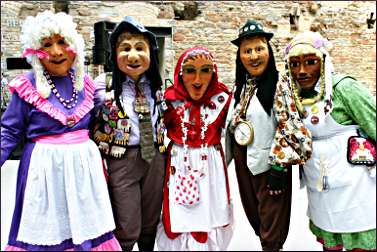
© Beth Gauper
Continuing our rounds, Torsten and I watched a performance of the Glockenspiel and drove up to Hermann Heights Park to visit Hermann, the warrior who united the Alemannic tribes and routed the Romans from the Teutoberg Forest in 9 A.D.
He's 32 feet of pure pagan, but the town loved him enough to order a $1.1 million renovation.
And we stopped by the Sausage Shop, where Torsten bought a dozen of his favorite Landjaeger sausages and the butcher sliced me a sample of Sultz — head cheese.
It wasn't always easy being German in New Ulm. In the days leading up to Prohibition, a temperance speaker called New Ulm "the vilest spot on the face of the Earth."
At the start of World War I, the governor removed the mayor and city attorney from office for questioning the war, and the town was viciously criticized throughout Minnesota.
Even neighboring Sleepy Eye put up a banner reading "Berlin — 10 miles east." And during World War II, out-of-towners who wanted to "kill a German" practiced on Hermann.
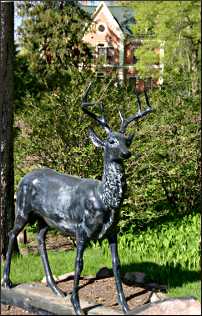
© Beth Gauper
But 99 percent of today's population was born American. In 2005, the city decided to discontinue Heritagefest, which once drew 40,000 people for two weekends of pilsener, pork buns and polka music, much of it performed by musicians flown in from Germany, Austria and Switzerland.
"They just didn't have the younger crowd there, and they're the ones who drink the beer," says Schell's Marti, whose early-spring Bock Fest has become so successful it nearly overwhelms the brewery.
Heritagefest was succeeded by Bavarian Blast, held downtown around German Park, amid gardens and a fountain. There's polka but also an art fair, a coffee and wine cafe with classical piano, a street dance, swing bands and events for kids and teens.
Resident Richard Runck told us that visitors need to be patient when looking for the German New Ulm.
"The Germans, they come over here with great aspirations of seeing a German village, and they're somewhat disappointed," he said.
"It's almost like an archaeological site now. You'll find little pieces of evidence remaining if you go around town, but as a collection, it's not together. You've got to know what you're looking for before you see it."
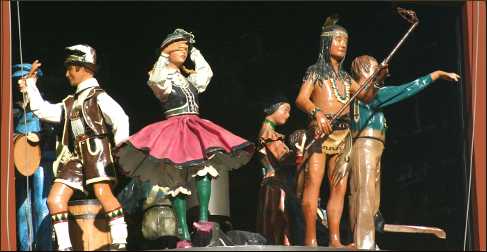
© Beth Gauper
From beer to wine
It's no theme park, that's for sure. And this town of supposedly thirsty Germans doesn't even have a beer garden where people can sit on balmy summer nights.
It does, however, have a truly excellent wine patio. Eight miles east of New Ulm, Ted Marti's brother Georg runs Morgan Creek Vineyards, with a winery built into a landscaped hillside.
When we stopped by on a Saturday evening, a jazz trio was playing, Marti was pouring wine and the stone patio was filled with laughing people eating pizza from a wood-fired oven and enjoying a view of bucolic countryside that included a low red barn and the most magnificent oak tree we'd ever seen.
"It was definitely a selling point when we bought it," Marti said.
The venture, he said, came about entirely through serendipity. He stumbled across the spot while he was looking for firewood and started a winery after someone suggested he grow grapes.
He serves pizzas because he was looking for an outdoor bread oven, but one of his cooking-class guests who sells them said they make great pizza.
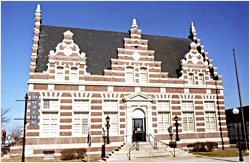
© Beth Gauper
On a warm spring night, the atmosphere was enchanting.
So we didn't see any half-timbered buildings or geraniums tumbling picturesquely out of window boxes. But we had a good time, Torsten got a taste of home, and we met a lot of really nice folks.
"What you see here is real and authentic," said Richard Runck. "It's just not what people imagine it to be."
Trip Tips: New Ulm, Minnesota
Getting there: It's 1¾ hours west of the Twin Cities, longer during rush hours.
Annual events: First Saturday in March, Bock Fest at Schell's (for more, see A German Mardi Gras ). Mid-July, Bavarian Blast in German Park. First two weekends of October, Oktoberfest.
Accommodations : Bingham Hall B&B is in a stately house on German Street near downtown and has four bedrooms.
At the south end of Broadway, the Microtel Inn has an indoor pool, 507-354-9800, as does the Best Western.
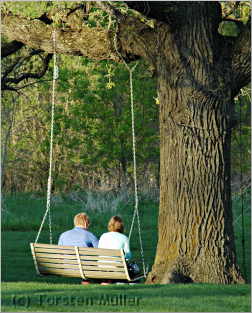
© Torsten Muller
Dining: On Minnesota Avenue downtown, Lola's American Bistro sandwiches, salads, soups, pasta and dinner entrees.
The Rathskeller at Turner Hall, a block south of downtown at First and State, has a salad bar and German and American food. 507-354-4916.
Downtown, George's Fine Steaks & Spirits serves lamb and duck as well as steaks and seafood, 507-354-7440.
Restaurants that serve German dishes include Veigl's Kaiserhoff, downtown.
Hermann Monument : The spiral staircase to the top of the dome is open daily from Memorial Day weekend through Labor Day, $3.
Glockenspiel: The bells ring and figures twirl at noon, 3 and 5 p.m.; during festivals, also at 10:30 a.m. and 1 p.m.
Wanda Gag House: The childhood home of the "Millions of Cats" author/illustrator is open weekends from mid-May to mid-October.
For more, see The artistic Gags of New Ulm.
Schell Brewery tours: The Bier Halle, gift shop and grounds are open daily year-round. Brewery tours are given daily from Memorial Day weekend to Labor Day and Fridays to Sundays the rest of the year, $10.
The brewery also offers an Into the Depths tour on the second or third Thursday of each month, $40, that takes visitors into the historic beer caves and original taproom as well as production facilities.
On the northwest side of town, the Starkeller taproom at 2215 N. Garden St. ages and serves Schell's sour beers.
Morgan Creek Vineyards: Eight miles east of New Ulm, the winery and gift shop is open Thursday through Sunday from May to October, Friday through Sunday in November and December and Saturdays-Sundays in April.
It holds many tastings, dinners and special events. 507-947-3547.
Bicycling: The city has mapped a 13-mile bike route around town.
Flandrau State Park : The park, which adjoins Schell Brewery in a wooded valley on the edge of town, has campsites, a pool with a sand bottom and 8½ miles of hiking trails, some on a bluff overlooking the Cottonwood River.
Information: New Ulm tourism, 888-463-9856.